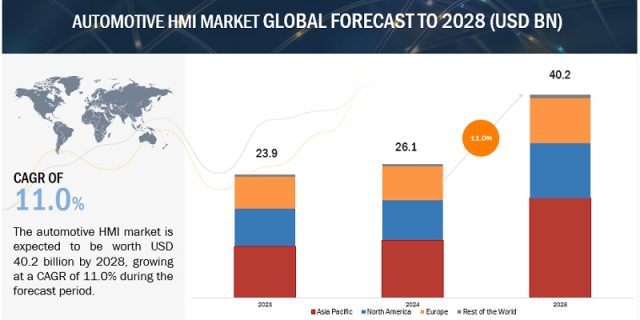
The automotive HMI market is projected to grow from USD 23.9 billion in 2023 to USD 40.2 billion by 2028, at a CAGR of 11.0%. An increase in awareness for driver safety, growing demand for easy accessibility solutions to multiple functions in vehicles, rise in demand for enhanced driving experience and increase in demand for technologies integrating with autonomous vehicles are some factors influencing the growth of the automotive HMI market.
Luxury Passenger Cars are predicted to be the largest application for Automotive HMI.
The automotive HMI market is expected to be dominated by luxury passenger cars as the demand for premium vehicles has grown significantly in recent years. According to MarketsandMarkets Analysis, the overall share of passenger vehicles (Class D and above) stood at >30% in 2022, which was ~20% in 2018 in Asia Pacific, Europe, and North America. These premium vehicles strongly emphasize premium features, pay attention to customer needs, integrate cutting-edge features, and generally command higher price tags than mass-market vehicles. This higher pricing allows luxury car manufacturers to install advanced HMI solutions such as the high-resolution touchscreen display with multiple connected capabilities, speech recognition and voice command, gesture recognition, HUD, and voice recognition system. The Mercedes-Benz S-Class, BMW 7 Series, Audi A8, and Tesla Model S are examples of luxury passenger car models that feature various HMI products. Thus, rising consumer acceptance of premium vehicles, especially in developing nations, would enable OEMs to standardize multiple automotive HMI products in this segment to provide additional comfort and a premium feel.
Download PDF Brochure @ https://www.marketsandmarkets.com/pdfdownloadNew.asp?id=109625825
The >10” display screen size is predicted to be the fastest-growing segment.
The > 10-inch display screen size is predicted to grow rapidly. This growth is driven by several factors, including the enhanced user experience provided by larger screens, the ability to integrate advanced functionalities and features, the contribution to design and aesthetics, technological advancements making larger screens more practical and affordable, and the competitive differentiation offered by larger screens. The growing premium car sales and increased adoption of a large central screen display in mid-priced passenger cars has also influenced the growth of >10” display screens. Tier 1 suppliers are developing cost-effective touchscreens with larger sizes without adding much difference to OEMs. This helps OEMs as a differentiating factor, especially in lower mid-priced cars where consumers are conscious about more features, which can drive their buying decision. Also, the large screen displays enhance safety with larger icons, fonts, and touch targets, allowing for better readability and reducing drivers’ need to divert their attention from the road while driving. Volkswagen Golf, Kia Seltos, and LADA Priora are some mid-priced passenger cars offering>10” display screens. Thus, the growth of high-end and mid-variant vehicles to enhance status quotient and aesthetic appeal would lead to the demand for large screen display sizes in coming years.
Asia Pacific is expected to account for the largest share of the Automotive HMI Market.
Advancements and developments in the field of vehicle manufacturing are driving the Asia-Pacific automotive HMI market. Countries such as China, South Korea, Japan, and India, among others, are the major contributors to the growth of automotive HMIs in the region. The vehicle manufacturing industry in Asia Pacific is rapidly growing, particularly in countries like China, Japan, South Korea, and India. Economy and mid-range passenger vehicles hold the largest share in developing countries such as China and India. These are cost-sensitive markets, and to cater to this, tier-1 suppliers offer cost-effective HMI solutions such as central display, steering control, voice command, etc. are increasingly becoming popular in the economy to high-end cars in developing countries. As a result, they have produced high-quality automotive HMIs at lower costs than other regions. However, a gradual rise in the demand for feature-rich features with some additional cost would drive the demand for the automotive HMI market in the region.
Key Market Players:
Major players operating in the automotive HMI market are Continental AG (Germany), Luxoft (Switzerland), Aptiv (Ireland), HARMAN International (US), Synaptics Incorporated (US), and Visteon Corporation (US).
Request Free Sample Report @ https://www.marketsandmarkets.com/requestsampleNew.asp?id=109625825

